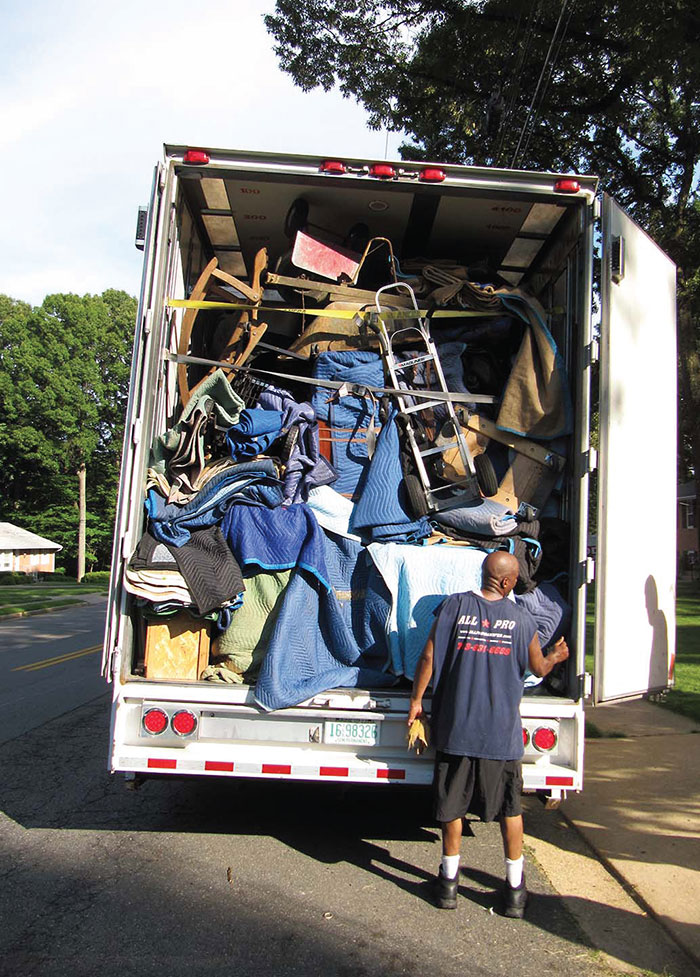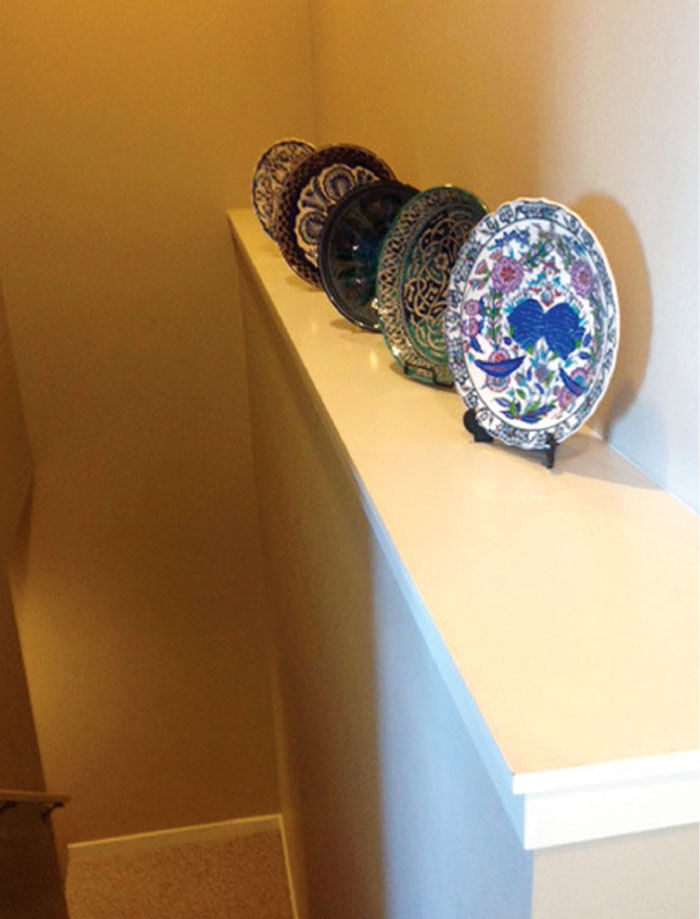EILEEN MALLOY, afsa.org
Here are some lessons learned on the retirement transition from a member of the Foreign Service who's been there recently.
BY EILEEN MALLOY

We are all set to go. When the moving van arrives, you will be glad you took the time to downsize.
Courtesy of Eileen Malloy
For my family, 2014 was the year of the big downsizing. For me, it was the perfect storm. I spent it helping to dispose of my father’s 80-year accumulation of art and artifacts; clearing my aunt’s beloved home of a lifetime of books, papers and knickknacks; and moving my own household from Virginia to Washington state—all while working part-time for the Office of the Inspector General as a WAE team leader.
Want to guess which of these three big tasks was the most difficult, time-consuming and expensive? My personal move, of course. It was the first time I had to move household effects at my own expense since joining the Foreign Service in 1978.
It was an arduous process and a serious learning experience for me. Here are some of the insights I gained and a list of pointers that may be helpful to others undertaking this transition.
So Much Stuff
Why do Foreign Service members accumulate so much paper? Why do we have such an accretion of unusual artifacts? When did we buy so many duplicates of the same household items? These are the questions I grappled with as I sorted through my things.
Paper. When you work for the State Department you attract paper files like lint in a multiple-pet household. Travel vouchers, decades of personnel actions, annual evaluations lauding your superior abilities, letters of appreciation, newspaper articles and references you swore you needed to consult but never did— they’re all accumulating down in those file boxes stashed in the attic or basement or self-storage locker.
Souvenirs, artifacts, treasures. You can tell an FSO’s first post of assignment by looking around his or her home. The majority of decorative items tend to be accumulated during one’s first overseas tour. After that there is a geometric decline in acquisition. As one progresses in one’s career, the “gifts” begin to accumulate. U.S. government ethics rules preclude acceptance of gifts from foreign governments unless they are under a certain dollar value, so we are not talking about pricey items here. For those of us who have served in less wealthy countries, such gifts are usually handmade items reflecting local culture, often inscribed by the giver with the recipient’s name, which makes them hard to re-gift.
Survival equipment for overseas duty in countries lacking a Wal-Mart. I held on to all the items I normally shipped in our air freight to use during that indeterminate period of time spent waiting for our household effects shipment to arrive. My logic was that these would be ideal for starter kitchens when the kids set out on their own, but it turns out that kids heading off to college prefer IKEA to Mom’s basement trove of vintage utensils and appliances.
As a result, my aging 220-volt appliances were collecting dust in the basement, right next to the home-canning jars and boiling pots we had needed in Central Asia. Then there were the four pairs of felt-lined boots, dozens of parkas and wool coats, and fur hats and coats I had acquired during multiple tours in Moscow.
Start Downsizing Now!
If you neglected to take advantage within the stipulated timeframe of the State Department relocation funding to move your household effects to your retirement home (see 14 FAM 584.2-2 for more info on this benefit) like I did, you need to start downsizing now. I gave myself a full year to accomplish this process and still ended up moving things to Washington state that I should have jettisoned back in Virginia.
Why does it take this long? You could just lock the door, walk away with a suitcase and have the junk man haul it all away. But you would run the risk of identity fraud from all those old documents with your Social Security number blowing around the landfill, or have trouble claiming capital improvements on your personal residence because you no longer have the receipts to prove you made those investments. Or you may need to produce receipts for official travel when audited by the bureau that funded the trip or by the Office of the Inspector General.
Have the Right Tools

One wall of reference books and mementos made the cut and are in their place in our new home.
Courtesy of Eileen Malloy
To downsize in a thoughtful manner, you will need the right tools. Here is what I recommend:
• A computer with sufficient storage space to hold scanned copies of those documents you need to retain
• A back-up electronic storage system to protect your e-files should your computer crash or be stolen
• A scanner connected to your computer
• A cross-cut shredder to deal with paper with sensitive personal information
• A magnifying glass for reading those old documents
• A sturdy paper file box for those documents that need to be retained in original paper form (deeds, for example).
Go Green
To downsize in an environmentally responsible manner, you need to keep as many of your extraneous household effects as possible out of the landfills. This means taking time to find places to sell, give away, donate or recycle what you no longer need. Look beyond Goodwill or the Salvation Army; you will find that there are many nongovernmental organizations interested in your ephemera.
I donated a carload of artifacts from my career to the U.S. Diplomacy Center Foundation (diplomacy.state.gov). Another carload went to theAssociates of the American Foreign Service Worldwide, for their annual Bookfair at the State Department.
If your 220-volt appliances are in good working order, find a new FSO out at the Foreign Service Institute who can use them on their first tour overseas. Remember how pressed financially you were when you first started in the Service?
We also used Freecycle (www.freecycle.org) to give away items we did not plan to take with us to our retirement home. Remember all those old record albums stored in boxes in the basement? The good news is that generation Y has rediscovered the beauty of high fidelity, and records are coming back into demand. As with all things, the rarity and the condition of the album will determine its value. The local record resale shop was quite excited to see my Paul McCartney album, issued only in the USSR in the late 1980s.
Items of Value
If you have valuable collector’s items you wish to sell, think through whether you want to take the time and effort to market them online (e.g., via Ebay or Amazon) or whether you want to use an auction or consignment house. We used auction houses to sell my father’s collections of bronzes, paintings, firearms and other antiques. One auction house, Cowan’s, was particularly helpful.
If the items have value, a good auction house will readily accept them for inclusion in their next catalog or for online sales in small batches. Ask around to find out which firms and consignment shops have been used by people you trust. Make sure you clarify what the auction house or consignment charges for their services before you turn over items to them for sale.
Especially valuable items will bring in more money if handled by a dealer or a specialized auction house, because they are more apt to know collectors who have an interest in such items. You would be wise to get estimates from several different dealers on your high-value items.
How do you find out whether your treasures are really as valuable as you think they are? The easy way is to look up the item on Ebay or Amazon. This will tell you the value of similar items being offered. But beware—this does not mean that anyone is actually paying that price. Still, it should give you an idea of what is collectible and what is just not worth your time and effort to sell.
Sadly, for those of us who love fine china and crystal, there is not much interest in sets of traditional china among the younger generations. Families today have no space to store grandmother’s china service for 12, nor do they care to use china that cannot be washed in a dishwasher. Select a few pieces you think you will actually use in your retirement home, and then consign or donate the remaining china service.
Deciding What to Keep
So how do you decide what to keep and what to shed? Obviously a very personal decision, it is also constrained by the location and size of your retirement home. Let’s assume you know where you will be moving and have a firm idea of the kind of housing you will occupy (e.g., single-family home or condo). That will give you an idea of what you can accommodate. In addition, I found that a good rule of thumb is to assume that it will cost you a dollar to move each pound of your household effects.
We decided to leave behind much of our furniture; it was worn after so many moves in and out of storage, and the style did not seem to fit with the Pacific Northwest. There is virtually no market these days for old, dark wood furniture (called “brown furniture” in the trade), so consider donating it to a charitable organization. The bright side of the cheap prices in vintage furniture is that you can buy replacements at your new location for a song. We picked up a mahogany dining table with two extensions and eight carved chairs for less than what it would have cost to ship my old table and chairs across the country. We have had fun trolling through consignment and antique shops to select replacement pieces for our new home.
Don’t think you can manage to do this culling on your own? Look for a senior real estate specialist in your local yellow pages or online. These people provide counseling and advice to people relocating into retirement homes. Or you can read up on the topic: one book that looks useful isBruce Nemovitz’s Moving in the Right Direction (Book Publisher's Network, 2006).
The Sorting Process

We used the stairwell in our new home to showcase our Central Asian plates.
Courtesy of Eileen Malloy
Sorting through those mountains of paper can be daunting. Do not succumb to the temptation to ship it with the idea of using that free time you think you will have in retirement to sort through it. First of all, those files are heavy (remember, $1 per pound); second, you will not have room in your retirement home to store all that paper. I worked through a couple of files each evening while the family watched TV. I set up two boxes: one for material to shred and the other for retention. It was easy to leaf through the files and separate the dross from the gold.
This is how I decided what to keep, what to toss and where to toss it:
• If it is related to your work at State, learn the rules on what must be retained and for how long. If you must keep it, decide if you can retain a scanned copy and dispose of the paper copy. For example, I scan the first page of travel vouchers so I have proof the voucher was filed, and then shred the actual voucher. If the travel was recent, I retain the original receipts.
• If it is a personal document, decide whether you will need it in the future for tax or insurance purposes. If so, will a scan suffice or do you need the original? If it is not needed, shred it.
• If the document is related to your family history, you may consider keeping a scanned copy for your relatives. If it is something unusual, you may wish to retain the original.
• When in doubt, always shred receipts. Remember that old receipts had the full credit card number printed on them, and many checks and old State personnel documents have your SSN on them somewhere.
Photographic Memories
Those of you who travel lean may only have a few snapshots of your favorite people and places. Of course you will take all those with you. Shutterbugs like me, however, have thousands of digital images stored on our computer and boxes of old negatives waiting to be scanned. I also have photos and negatives going back to 1902, which were taken by my grandfather and father. Most of you will be somewhere in the middle in terms of the volume of video and photo holdings. Here’s how I would suggest you approach downsizing:
• Do a survey to identify exactly what you have and what form it is in, then sit down with your family to decide what kinds of images should be saved. Even if you have been diligent about photo albums, and you already have all your best pictures in those, odds are that your retirement residence will not have sufficient space to store them all.
• Explore digital scanning of your negatives and photos. Once that is done, you can select your favorite photos and use them to decorate your new home. It is easy to create collages or to touch up a faded image. Make sure that you have a good back-up storage system for your photos so that you do not lose them in the event of a computer malfunction. (We store a separate hard drive with a backup of our computer files in a safe deposit box.)
• If you have photos that document Foreign Service life or international events or people of note, consider offering them to the Association for Diplomatic Studies and Training (www.adst.org) for use in the oral history program. ADST will accept relevant photos provided they are already scanned into JPEG format and are accompanied by a brief description of the photo’s content (who, what, where, when). You also can offer such photos to the U.S. Diplomacy Center, which is collecting photos relevant to diplomatic history.
• Create boxes of family photos for relatives (kids and grandkids, in particular) to explore. My grandchildren love to see pictures of their mother when she was a child. I let them take any of these pictures they wish to have because I have them all in digital form. My cousins were very happy to find pictures of long-forgotten family gatherings showing their parents (my aunts and uncles) back in the 1950s. I gave away about half of my old photos this way.
Let It Go!
You cannot save every item documenting your life. The key is to retain only the most important ones and find a good home for all the others. That is why you need a full year to accomplish downsizing. You will find that you will need to examine the same collection more than once, each time winnowing out a few more items.
Believe me: The day that moving van pulls up to your door, you will be glad you took the time to downsize.

2 comments:
HiJohn, It's cool stuff no doubt. You really did a tremendously wholesome work regarding the downsizing issue.It's really a big task. Though such type of work is not so easy to complete,you made it so easy and lesson-worth. Startup, right tools, items of value, what to keep, sorting process everything stated here in this post is awesome and admirable. Hope everyone taking a tour will surely be benefited like me. In fact I was looking for some ideas on how to help parents downsize and found your great content and definitely enjoyed your efforts.
Post a Comment